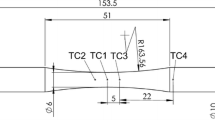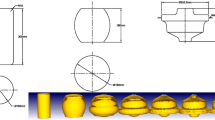Abstract
In the fabrication of heat-treatable aluminum parts such as AA2618 compressor impellers for turbochargers, solutionizing and quenching are key steps to obtain the required mechanical characteristics. Fast quenching is necessary to avoid coarse precipitation as it reduces the mechanical properties obtained after heat treatment. However, fast quenching induces residual stresses that can cause unacceptable distortions during machining. Furthermore, the remaining residual stresses after final machining can lead to unfavorable stresses in service. Predicting and controlling internal stresses during the whole processing from heat treatment to final machining is therefore of particular interest to prevent negative impacts of residual stresses. This problem is multiphysics because processes such as heat transfer during quenching, precipitation phenomena, thermally induced deformations, and stress generation are interacting and need to be taken into account. The problem is also multiscale as precipitates of nanosize form during quenching at locations where the cooling rate is too low. This precipitation affects the local yield strength of the material and thus impacts the level of macroscale residual stresses. A thermomechanical model accounting for precipitation in a simple but realistic way is presented. Instead of modelling precipitation that occurs during quenching, the model parameters are identified using a limited number of tensile tests achieved after representative interrupted cooling paths in a Gleeble machine. The simulation results are compared with as-quenched residual stresses in a forging measured by neutron diffraction.









Similar content being viewed by others
References
G. Pouget and C. Sigli, Mater. Sci. Forum 794, 691 (2014).
J.M. Drezet and A. Phillion, Metall. Mater. Trans. A 41, 3396 (2010).
N. Chobaut (Ph.D. Thesis, École Polytechnique Fédérale de Lausanne, Lausanne, Switzerland, 2015).
P. Pilvin, G. Cailletaud, Proceedings of the second International Symposium on Inverse Problems, eds. H.D. Bui, M. Tanaka, M. Bonnet, H. Maigre, E. Luzzato, and M. Reynier (Leiden, The Netherlands: CRC Press/Balkema, 1994), pp. 79–86.
M.E. Fitzpatrick and A. Lodini, Analysis of Residual Stress by Diffraction Using Neutron and Synchrotron Radiation (Boca Raton: CRC Press, 2003).
N. Chobaut et al., Proceedings of ICAA13, eds. H. Weiland, A.D. Rollett, and W.A. Cassada (Materials Park, OH: TMS, 2012), pp. 285–291.
D. Büche, N. Hofmann, and P. Sälzle (Paper presented at the NAFEMS World Congress, 2005).
G. Michel, Investigation of the Build-Up of Residual Stresses in Large Impellers During Quenching (internal report, Laboratoire de Simulation des Materiaux, 2014).
Acknowledgements
This work was funded by the Competence Center for Materials Science and Technology (http://www.ccmx.ch/) in the frame of the project titled, “Measurements and Modeling of RS During Quenching of Thick Heat Treatable Aluminum Components in Relation to their Microstructure” involving EPF Lausanne, PSI Villigen, Univ. Bretagne-Sud Lorient, Constellium CRV, and ABB Turbo Systems Ltd. The Gleeble 3500 machine of Univ. Bretagne-Sud was co-financed by European Regional Development Fund (ERDF). The authors are indebted to J. Beijers (ABB Turbo Systems Ltd) for finite-element simulations, W. Erb (ABB Turbo Systems Ltd) for TC instrumentation of the forgings, and J. Costa (Univ. Bretagne-Sud) for the instrumentation and M. Carin (Univ. Bretagne-Sud) for thermoelectrical modeling of the Gleeble tests. The authors are grateful to the international neutron source beam line scientist, Th. Pirling, at the Institut Laue Langevin for the provision of beam time.
Author information
Authors and Affiliations
Corresponding author
Rights and permissions
About this article
Cite this article
Chobaut, N., Saelzle, P., Michel, G. et al. Quench-Induced Stresses in AA2618 Forgings for Impellers: A Multiphysics and Multiscale Problem. JOM 67, 984–990 (2015). https://doi.org/10.1007/s11837-015-1363-2
Received:
Accepted:
Published:
Issue Date:
DOI: https://doi.org/10.1007/s11837-015-1363-2




